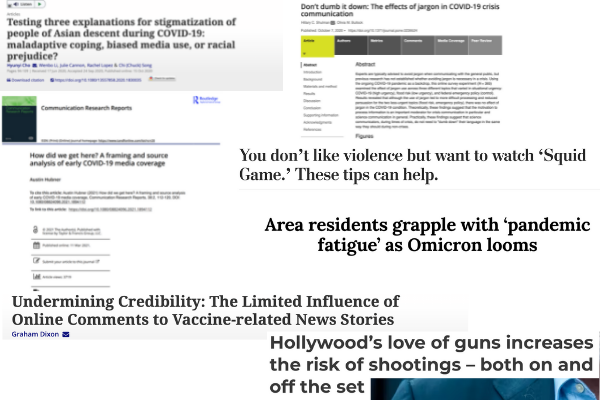
The School of Communication maintains its distinction as a top research institution worldwide, publishing more than 80 articles in influential journals in 2020 and providing thought leadership to decision-makers and media outlets throughout the country and globe.
The school conducted multiple studies related to the pandemic, as well as on other current topics like violence in the media, politics, health communication and the impact of social media.
COVID-19 Research
How the Media Framed COVID-19
During the early months of the COVID-19 outbreak and in the early stages of United States’ lockdown procedures, media coverage was the main source of credible information. The way media frames information can largely impact the way it is understood, especially important during a crisis such as a pandemic.

PhD student Austin Hubner’s research study on the framing of the pandemic sought to analyze the impact the media has on information and how the public reacts.
“Despite the devastation that COVID-19 has generated, beliefs about the virus and its prevention measures are polarized in the United States,” said Hubner.
Hubner published his research on the early news coverage of COVID-19 in her journal article: “How Did We Get Here? A Framing and Source Analysis of Early COVID-19 Media Coverage.”
The study examined the first three months of COVID-19 news and revealed three main frames: attention to the outbreak stemming from Wuhan, China, case counting and societal consequences.
“Taken together, this shows that early news coverage was focused on two aspects of COVID-19: its spread and subsequent detrimental effect on society,” Hubner wrote in her journal article. “The focus on societal effects, rather than information regarding the health risks and expert community response, might be because the expert community was still largely uncertain about the cause, transmission, and subsequent health effects of COVID-19.”
The article also credits the polarization to the slow actions taken by the World Health Organization as it attempted to keep the public calm.
As such, news media attention turned to individual consequences, such as business closures, rather than the health effects of COVID-19. This focus might have grounded COVID-19 as a threat to one’s way of life rather than a serious threat to one’s health,” Huber said.
Pandemic Jargon
Assistant Professor Hillary Shulman and PhD candidate Olivia Bullock worked together to test the effect of jargon during crises in their journal article: “Don’t dumb it down: The effects of Jargon in COVID-19 Crisis Communication.”
Experts consistently avoid jargon when communicating to the general public. Shulman and Bullock’s research found this tactic becomes unnecessary in times of crisis.

“Practically, these findings suggest that science communicators, during times of crisis, do not need to ‘dumb down’ their language in the same way they should during non-crises,” they note in the article.
The pair conducted an online survey to test the effects of jargon in three conditions: COVID-19 pandemic, flood risk and
federal emergency policy. While jargon did affect both flood risk and federal emergency policy, the two lower risk conditions, no effect was found in the COVID-19 condition.
“We have done a lot of research on the topic of jargon, and it is hard to overstate just how negatively jargon is generally perceived,” Shulman said. “The fact that we did not find this relationship at the beginning of the pandemic was surprising and — we argue — indicates just how invested the public was (early on) in understanding this virus.”
Stigmatization of Asian Americans
Professor Hyunyi Cho researched the stigmatization of Asian Americans during the pandemic, publishing results in the journal article “Testing Three Explanations for Stigmatization of People of Asian Descent during COVID-19: maladaptive coping, biased media use, or racial prejudice?”
According to the research, blaming others during difficult circumstances is considered maladaptive.

“Some coping efforts in high threat situations can be maladaptive, where coping is emotion-focused rather than problem-focused,” she noted in the article.
The way the media portrays health issues can also lead to stigmatization.
The researchers “expected partisan cable television use and social media use would predict stigmatization.” But racial prejudice remained the strongest predictor of stigmatization.
In order to decrease stigmatization, Cho recommended “providing education and resources to the public.”
“Fostering collective efficacy and media-based contacts with Asian Americans can facilitate these efforts,” Cho said.
Media and Vaccine Hesitancy
Assistant Professor Graham Dixon researches how diverse audiences process and react to polarizing and controversial topics.
In his article “Undermining Credibility: The Limited Influence of Online Comments to Vaccine-related News Stories,” Dixon addressed the way both online comments and state sponsored disinformation campaigns affect vaccine hesitancy.
“While exposure to anti-vaccine comments did not affect participants’ views of vaccines or their willingness to discuss vaccines, participants holding pro-vaccine views reported lower confidence in news organizations and viewed the journalist who authored their article as less credible,” Dixon said. “These results suggest that anti-vaccine comments may produce effects that align with the goals of state-sponsored disinformation campaigns.”
Current Events
“Squid Game”
Professor Brad Bushman was quoted in The Washington Post in an article titled “You don’t like violence but you want to watch ‘Squid Game.’ These tips can help.”
Hit show “Squid Game,” a South Korean turned global Netflix original series, follows fictional players competing in children’s games for a cash prize. If players lose a game, they are killed, often in gruesome and violent scenes.
“The research shows that exposure to violent media increases aggressive thoughts,” said Bushman in the article.
He explained that brief exposures to violent media can increase aggressive thoughts and behavior, and that duration of violent media makes the largest impact.

Alec Baldwin Fatal Prop Gun Shooting
Alec Baldwin recently fired a prop gun on the set of “Rust,” killing cinematographer Halyna Hutchins, according to The New York Times. Investigators found the gun held live ammunition despite Baldwin
being told the firearm was not loaded.
Following this incident, The Conversation featured Bushman in an article titled “Hollywood’s love of guns increases the risk of shootings – both on and off the set.”
“In featuring guns so heavily, there is a danger that Hollywood is not merely reflecting society – it is encouraging firearm sales,” Bushman wrote.
Dave Chappelle’s Transgender Remarks
USA Today quoted Professor Lanier Holt in response to comedian Dave Chappelle’s remarks about the transgender community.
The article reports on Chappelle making “jokes about the trans community” in his Netflix special, “The Closer.”
Holt responded to Chappelle’s comments in the USA Today article: "There's a long history of homophobia and acceptance of racism in the Black community, be it in our churches and in our satire. What we're ultimately doing is under the guise of humor, making it seem like it's OK or celebrated or worse, that it's funny. And there's nothing funny about it."

Omicron Variant
Dayton Daily News recently quoted Professor Graham Dixon about COVID-19 fatigue.
“People experience low efficacy when they feel they can’t do anything about an issue or they engage in information avoidance,” he said.
It can be difficult to communicate to the public why new science means guidance has to change, Dixon said in the article. He also reminds health professionals and leaders to continue to highlight safety practices — get the vaccine and boosters, wear face masks — as fatigue grows stronger.
